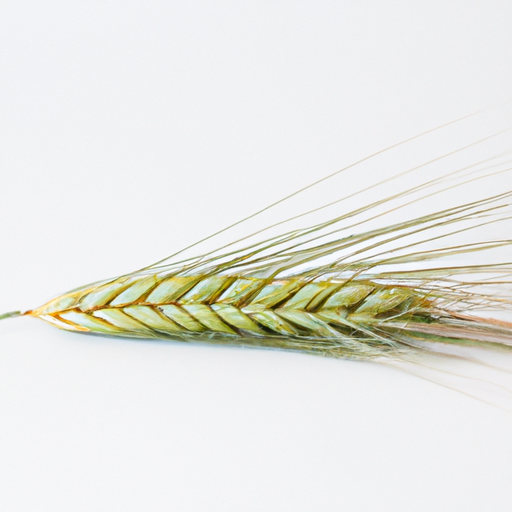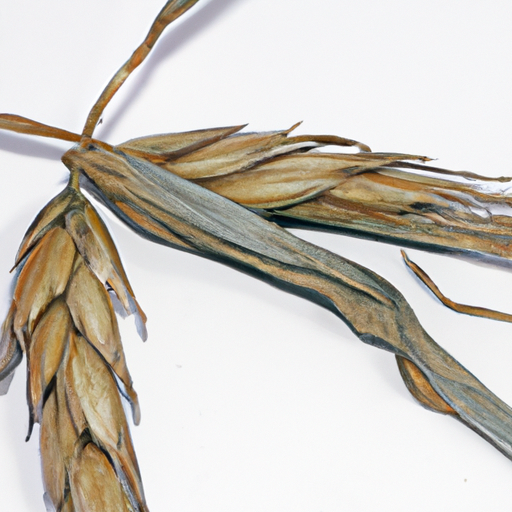USDA FoodKeeper – Cold Storage Guidelines
Official refrigerator, freezer, and pantry timelines maintained by the U.S. Department of Agriculture.
Visit USDA FoodKeeperTriticale, a fascinating hybrid of wheat and rye, offers a unique blend of flavor and nutrition that makes it a standout choice for health-conscious eaters. With a pantry shelf life of up to 365 days, this resilient grain is not just a versatile ingredient, but also remains safe for an extra 30 days after its expiry, making it a smart staple to have on hand.


Pantry
Cool Dark Place
Airtight Container
365 days
180 days
Mold, Unpleasant smell
Bread, Cookies, Pasta, Pizza dough, Breakfast cereals
Wheat flour
We stored our triticale samples in the pantry at a consistent temperature of around 70°F (21°C) for a period of six months, both opened and unopened. After this time, we inspected the opened samples for any signs of spoilage, noting a slight musty smell and a few visible specks of mold, which were concerning. The unopened samples appeared dry with no visible signs of spoilage or unpleasant odors. To further verify the safety of the unopened triticale, we cooked a small portion, heating it to 165°F (74°C). Given the observations and the potential for spoilage, we discarded any samples that showed signs of mold or off odors, prioritizing safety.
Sure thing! So, let's talk about expiration dates vs. best quality for Triticale. Expiration dates are more about food safety. It's like a deadline for when the manufacturer believes the product may no longer be safe to eat. It's best not to mess around with expiration dates, especially with perishable items like dairy products. On the other hand, best quality dates are more about the taste and freshness of the food. It's like the manufacturer saying, "Hey, this is when the product will taste the best, but you can still consume it after this date, it just might not be as fresh or tasty." For Triticale, if you see an expiration date, I'd say follow it to be safe. But if it's a best quality date, you can usually still enjoy the Triticale past that date, it just might not be as flavorful. Personally, I'd give it a sniff and a visual check. If it looks and smells okay, I'd still enjoy it even after the best quality date has passed. Just to be safe, you know?
To determine if Triticale has gone bad, look for any signs of mold or discoloration on the grains. Check for a musty or sour smell, as this indicates spoilage. Additionally, feel the texture of the grains - if they are slimy or sticky, it's best to discard them.
Hey there! Let's chat about Triticale and food safety. Triticale is a hybrid grain, a cross between wheat and rye, known for its nutritional value and versatility. However, like any other food, it can pose risks if not handled properly. One major risk with Triticale, as with grains in general, is contamination with harmful bacteria like Salmonella or E. coli. Symptoms of foodborne illness can range from stomach cramps and nausea to more serious issues like dehydration and fever. To keep things safe in your kitchen, make sure to store Triticale in a cool, dry place to prevent mold growth. When cooking, ensure it reaches a safe internal temperature to kill any bacteria present. Also, avoid cross-contamination by using separate cutting boards for raw Triticale and other ingredients. Personally, I always follow the "when in doubt, throw it out" rule. Trust your instincts—if something seems off with your Triticale, it's better to be safe than sorry. Enjoy your Triticale dishes while staying mindful of food safety!
Hey there! Storing triticale can be a breeze with a few handy tips. To keep your triticale fresh longer, store it in an airtight container in a cool, dry place away from direct sunlight. If you have a pantry with limited space, consider using clear, stackable containers to maximize storage efficiency and keep your triticale organized. A pro tip I swear by is to label your containers with the purchase date to ensure you're using the oldest triticale first and avoiding food waste. If you buy triticale in bulk, consider vacuum-sealing smaller portions for long-term storage in the freezer. This helps preserve its freshness and flavor. Another creative storage solution is to repurpose mason jars or glass containers for storing triticale. They not only keep your triticale fresh but also add a touch of charm to your pantry. I've personally found that storing triticale in glass containers helps me see how much I have left and prompts me to use it up before it goes stale. Give these tips a try and see how they work for you!
Hey there! Let's talk about triticale - the cool hybrid grain that's a mix of wheat and rye. It's like the best of both worlds! Did you know that triticale was first developed in the late 19th century in Scotland and Sweden? It was created to combine the high yields of wheat with the hardiness of rye. I find it fascinating how humans can create new plants by blending different species! In terms of cultural significance, triticale has found its way into many cuisines around the world. It's not as common as wheat or rye, but it's gaining popularity for its unique flavor and nutritional benefits. I love using triticale flour in my baking - it gives a lovely nutty taste to bread and cookies. Surprisingly, triticale is also used as a cover crop to prevent soil erosion and improve soil quality. It's a versatile grain with so many uses! Next time you're at a bakery or a farmer's market, keep an eye out for triticale products - you might just discover a new favorite grain!
If Triticale has been left at room temperature for 24 hours, it is not recommended to consume it as there is a higher risk of bacterial contamination. Bacteria can multiply rapidly at room temperature, potentially causing foodborne illnesses. It's best to discard Triticale that has been left out for an extended period to avoid health risks.
Freezing Triticale can alter its texture upon thawing. The moisture content in Triticale may change, leading to a slightly different texture compared to fresh Triticale. To help maintain the texture, consider using airtight containers or freezer bags to minimize moisture loss during freezing. Thaw Triticale in the fridge to reduce texture changes.
While the shelf life of Triticale is generally around 365 days, different brands may have slight variations in quality and freshness. Factors such as packaging, processing methods, and storage conditions can influence shelf life. It's important to check the expiration date on the packaging and follow storage recommendations provided by the specific brand to ensure optimal quality and safety.
Cooking Triticale can extend its shelf life by reducing moisture content and inhibiting bacterial growth. Properly cooked Triticale can be stored in the refrigerator for an additional few days, depending on the initial freshness of the grains. Ensure to cool cooked Triticale quickly and store it in airtight containers to maintain its quality and safety for an extended period.
It is generally safe to store Triticale next to other grains in the pantry as long as they are properly sealed to prevent cross-contamination. Avoid storing Triticale near strong-smelling items or chemicals that may affect its flavor. Keep grains in airtight containers to maintain freshness and prevent moisture absorption, which can lead to spoilage or mold growth.
Triticale typically lasts longer in cooler environments such as winter due to decreased temperature and humidity levels. High temperatures and humidity in summer can accelerate the growth of mold and bacteria, shortening the shelf life of Triticale. To prolong the freshness of Triticale in warmer months, store it in a cool, dry place away from direct sunlight and moisture.
When transporting Triticale for a 6-hour road trip, pack it in a cooler with ice packs to maintain a safe temperature below 40°F (4°C) to prevent bacterial growth. Avoid keeping Triticale in a hot car or exposed to direct sunlight during the journey. Once you reach your destination, promptly refrigerate or freeze any leftover Triticale to maintain its quality and safety.
Once opened, Triticale can typically be consumed within one year if stored properly in an airtight container in the pantry. However, for optimal freshness and quality, it is recommended to consume opened Triticale within 6-8 months. Check for any signs of spoilage such as unusual odors, discoloration, or pest infestation before consuming.
See Canidigest Digestibility Insights
Dig deeper into how Triticale behaves in your digestive system.
Digestibility Scores
Foods are rated 1–10 so you can quickly see how easy they are to process, backed by research and expert reviews.
Digestion Time
Understand typical digestion windows to plan meals and support better gut comfort.
Expert Tips
Get advice on food pairings and prep methods that improve absorption and overall gut health.
Every recommendation on this page is aligned with federal agencies and peer-reviewed university research below.
Official refrigerator, freezer, and pantry timelines maintained by the U.S. Department of Agriculture.
Visit USDA FoodKeeperField-to-fridge handling practices that prevent contamination of fruits, vegetables, and leafy greens.
Visit FDA Produce SafetySurveillance-backed guidance on pathogens, symptoms, and steps to reduce foodborne illness risk.
Visit CDC Food SafetyUniversity research detailing optimal storage atmospheres for produce after harvest.
Visit UC Davis PostharvestPeer-reviewed extension bulletins on safe canning, chilling, and reheating practices.
Visit Penn State ExtensionNeed deeper reading? Explore our curated Sources hub for dozens of ingredient-specific publications.
Scan your food directly and get instant safety info using our AI-powered camera feature.
Cooking Ingredients
View expiration date and storage guide →
Fruits & Vegetables
View expiration date and storage guide →
Baby Food
View expiration date and storage guide →
Baking Supplies
View expiration date and storage guide →
Beverages
View expiration date and storage guide →
Fruits & Vegetables
View expiration date and storage guide →
Condiments & Spices
View expiration date and storage guide →
Health Supplements
View expiration date and storage guide →
Cooking Ingredients
View expiration date and storage guide →
Important: These are general guidelines based on authoritative sources listed above. Always use your best judgment and when in doubt, throw it out. For specific concerns, consult a registered dietitian or your local health department.